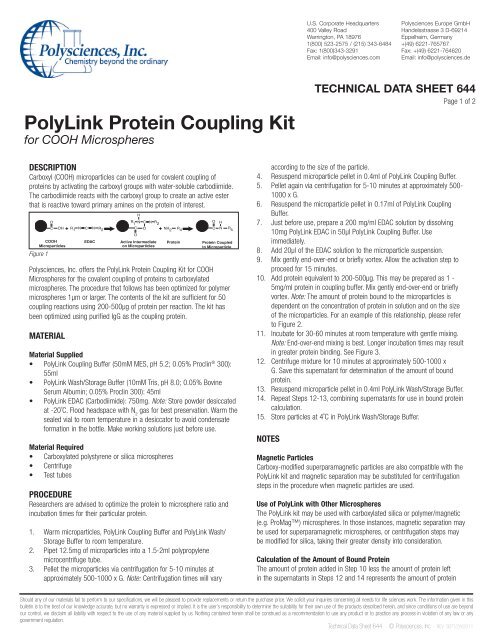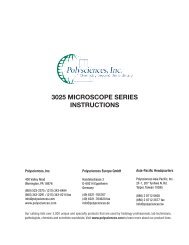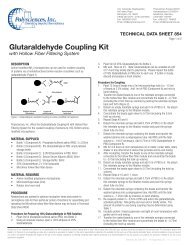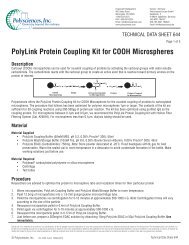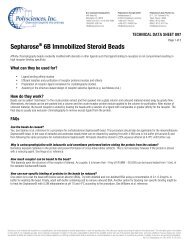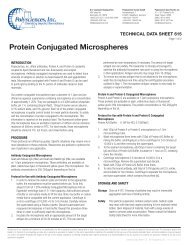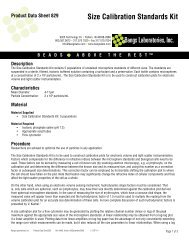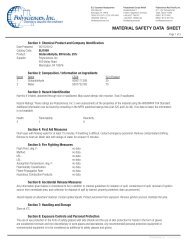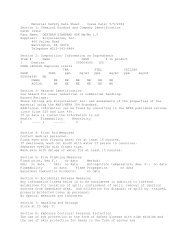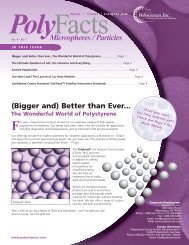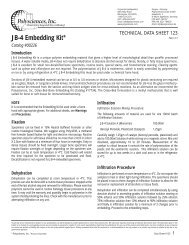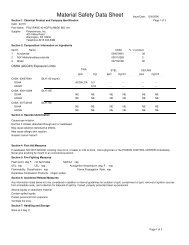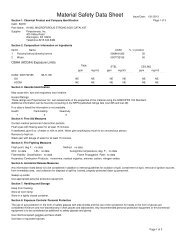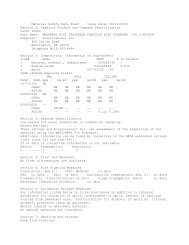PolyLink Protein Coupling Kit - Polysciences, Inc.
PolyLink Protein Coupling Kit - Polysciences, Inc.
PolyLink Protein Coupling Kit - Polysciences, Inc.
You also want an ePaper? Increase the reach of your titles
YUMPU automatically turns print PDFs into web optimized ePapers that Google loves.
U.S. Corporate Headquarters<br />
400 Valley Road<br />
Warrington, PA 18976<br />
1(800) 523-2575 / (215) 343-6484<br />
Fax: 1(800)343-3291<br />
Email: info@polysciences.com<br />
<strong>Polysciences</strong> Europe GmbH<br />
Handelsstrasse 3 D-69214<br />
Eppelheim, Germany<br />
+(49) 6221-765767<br />
Fax: +(49) 6221-764620<br />
Email: info@polysciences.de<br />
<strong>PolyLink</strong> <strong>Protein</strong> <strong>Coupling</strong> <strong>Kit</strong><br />
for COOH Microspheres<br />
TECHNICAL DATA SHEET 644<br />
Page 1 of 2<br />
DESCRIPTION<br />
Carboxyl (COOH) microparticles can be used for covalent coupling of<br />
proteins by activating the carboxyl groups with water-soluble carbodiimide.<br />
The carbodiimide reacts with the carboxyl group to create an active ester<br />
that is reactive toward primary amines on the protein of interest.<br />
COOH<br />
Microparticles<br />
Figure 1<br />
<strong>Polysciences</strong>, <strong>Inc</strong>. offers the <strong>PolyLink</strong> <strong>Protein</strong> <strong>Coupling</strong> <strong>Kit</strong> for COOH<br />
Microspheres for the covalent coupling of proteins to carboxylated<br />
microspheres. The procedure that follows has been optimized for polymer<br />
microspheres 1µm or larger. The contents of the kit are sufficient for 50<br />
coupling reactions using 200-500µg of protein per reaction. The kit has<br />
been optimized using purified IgG as the coupling protein.<br />
MATERIAL<br />
EDAC<br />
Active Intermediate<br />
on Microparticles<br />
<strong>Protein</strong><br />
Material Supplied<br />
• <strong>PolyLink</strong> <strong>Coupling</strong> Buffer (50mM MES, pH 5.2; 0.05% Proclin ® 300):<br />
55ml<br />
• <strong>PolyLink</strong> Wash/Storage Buffer (10mM Tris, pH 8.0; 0.05% Bovine<br />
Serum Albumin; 0.05% Proclin 300): 45ml<br />
• <strong>PolyLink</strong> EDAC (Carbodiimide): 750mg. Note: Store powder desiccated<br />
at -20˚C. Flood headspace with N 2<br />
gas for best preservation. Warm the<br />
sealed vial to room temperature in a desiccator to avoid condensate<br />
formation in the bottle. Make working solutions just before use.<br />
Material Required<br />
• Carboxylated polystyrene or silica microspheres<br />
• Centrifuge<br />
• Test tubes<br />
<strong>Protein</strong> Coupled<br />
to Microparticle<br />
PROCEDURE<br />
Researchers are advised to optimize the protein to microsphere ratio and<br />
incubation times for their particular protein.<br />
1. Warm microparticles, <strong>PolyLink</strong> <strong>Coupling</strong> Buffer and <strong>PolyLink</strong> Wash/<br />
Storage Buffer to room temperature.<br />
2. Pipet 12.5mg of microparticles into a 1.5-2ml polypropylene<br />
microcentrifuge tube.<br />
3. Pellet the microparticles via centrifugation for 5-10 minutes at<br />
approximately 500-1000 x G. Note: Centrifugation times will vary<br />
according to the size of the particle.<br />
4. Resuspend microparticle pellet in 0.4ml of <strong>PolyLink</strong> <strong>Coupling</strong> Buffer.<br />
5. Pellet again via centrifugation for 5-10 minutes at approximately 500-<br />
1000 x G.<br />
6. Resuspend the microparticle pellet in 0.17ml of <strong>PolyLink</strong> <strong>Coupling</strong><br />
Buffer.<br />
7. Just before use, prepare a 200 mg/ml EDAC solution by dissolving<br />
10mg <strong>PolyLink</strong> EDAC in 50µl <strong>PolyLink</strong> <strong>Coupling</strong> Buffer. Use<br />
immediately.<br />
8. Add 20µl of the EDAC solution to the microparticle suspension.<br />
9. Mix gently end-over-end or briefly vortex. Allow the activation step to<br />
proceed for 15 minutes.<br />
10. Add protein equivalent to 200-500µg. This may be prepared as 1 -<br />
5mg/ml protein in coupling buffer. Mix gently end-over-end or briefly<br />
vortex. Note: The amount of protein bound to the microparticles is<br />
dependent on the concentration of protein in solution and on the size<br />
of the microparticles. For an example of this relationship, please refer<br />
to Figure 2.<br />
11. <strong>Inc</strong>ubate for 30-60 minutes at room temperature with gentle mixing.<br />
Note: End-over-end mixing is best. Longer incubation times may result<br />
in greater protein binding. See Figure 3.<br />
12. Centrifuge mixture for 10 minutes at approximately 500-1000 x<br />
G. Save this supernatant for determination of the amount of bound<br />
protein.<br />
13. Resuspend microparticle pellet in 0.4ml <strong>PolyLink</strong> Wash/Storage Buffer.<br />
14. Repeat Steps 12-13, combining supernatants for use in bound protein<br />
calculation.<br />
15. Store particles at 4˚C in <strong>PolyLink</strong> Wash/Storage Buffer.<br />
NOTES<br />
Magnetic Particles<br />
Carboxy-modified superparamagnetic particles are also compatible with the<br />
<strong>PolyLink</strong> kit and magnetic separation may be substituted for centrifugation<br />
steps in the procedure when magnetic particles are used.<br />
Use of <strong>PolyLink</strong> with Other Microspheres<br />
The <strong>PolyLink</strong> kit may be used with carboxylated silica or polymer/magnetic<br />
(e.g. ProMag) microspheres. In those instances, magnetic separation may<br />
be used for superparamagnetic microspheres, or centrifugation steps may<br />
be modified for silica, taking their greater density into consideration.<br />
Calculation of the Amount of Bound <strong>Protein</strong><br />
The amount of protein added in Step 10 less the amount of protein left<br />
in the supernatants in Steps 12 and 14 represents the amount of protein<br />
Should any of our materials fail to perform to our specifications, we will be pleased to provide replacements or return the purchase price. We solicit your inquiries concerning all needs for life sciences work. The information given in this<br />
bulletin is to the best of our knowledge accurate, but no warranty is expressed or implied. It is the user’s responsibility to determine the suitability for their own use of the products described herein, and since conditions of use are beyond<br />
our control, we disclaim all liability with respect to the use of any material supplied by us. Nothing contained herein shall be construed as a recommendation to use any product or to practice any process in violation of any law or any<br />
government regulation.<br />
Technical Data Sheet 644 © <strong>Polysciences</strong>, <strong>Inc</strong>. - REV: SEPT/29/2011
TECHNICAL DATA SHEET 644<br />
Page 2 of 2<br />
bound to the microparticles. <strong>Protein</strong> concentrations of the starting solution<br />
and supernatants after binding may be determined by measuring the<br />
absorbance at 280nm or by utilizing commercial protein assay kits. Note: If<br />
measuring absorbance at 280nm, solutions used for calculation of bound<br />
protein should not contain EDAC. EDAC may contribute to the absorbance<br />
at 280nm.<br />
Example:<br />
[ ]-[ ] /<br />
=<br />
µg of protein µg of protein in mg of<br />
in starting wash supernatants microparticles<br />
solution<br />
µg of protein bound/mg microparticles<br />
[ ]-[ ] /<br />
=<br />
100µg of 45µg of protein in 12.5mg of<br />
protein in wash supernatants microparticles<br />
starting solution<br />
4.4µg of protein bound/mg microparticles<br />
TRADEMARKS AND REGISTERED TRADEMARKS<br />
1. ProClin ® is a registered trademark of Rohm & Haas Company.<br />
2. ProMag is a trademark of <strong>Polysciences</strong>, <strong>Inc</strong>.<br />
STORAGE<br />
Store <strong>PolyLink</strong> buffers at 2-8˚C. Coated particles should be stored at 2-8˚C<br />
in <strong>PolyLink</strong> Wash/Storage Buffer or other suitable storage buffer. Store<br />
EDAC desiccated at -20˚C. Freezing of particles may result in irreversible<br />
aggregation and loss of binding activity.<br />
This product is for research use only and is not intended for use in<br />
humans or for in vitro diagnostic use.<br />
ORDERING INFORMATION<br />
Cat. # Description Size<br />
24350 <strong>PolyLink</strong> <strong>Protein</strong> <strong>Coupling</strong> <strong>Kit</strong> 1 kit<br />
Expected Results<br />
Figure 2: The Effect of Particle Size on <strong>Protein</strong> Binding at Equal Solids. Three<br />
different sizes of carboxyl microspheres were exposed to three different levels of<br />
Goat anti-Rat IgG protein. The smaller particles represent more surface area per<br />
unit of mass and therefore bind more total protein.<br />
Figure 3: Time Course of <strong>Protein</strong> Binding. Three different levels of protein were<br />
used in the <strong>PolyLink</strong> procedure using 3µm carboxyl microspheres. As expected,<br />
more input protein results in more protein bound. The majority of the protein<br />
binding occurs in the first 30 minutes.<br />
TO ORDER<br />
In The U.S. Call: 1(800) 523-2575 • (215) 343-6484<br />
In The U.S. Fax: 1(800) 343-3291 • (215) 343-0214<br />
In Germany Call: +(49) 6221-765767<br />
In Germany Fax: +(49) 6221-764620<br />
Order online anytime at www.polysciences.com<br />
Should any of our materials fail to perform to our specifications, we will be pleased to provide replacements or return the purchase price. We solicit your inquiries concerning all needs for life sciences work. The information given in this bulletin<br />
is to the best of our knowledge accurate, but no warranty is expressed or implied. It is the user’s responsibility to determine the suitability for their own use of the products described herein, and since conditions of use are beyond our control,<br />
we disclaim all liability with respect to the use of any material supplied by us. Nothing contained herein shall be construed as a recommendation to use any product or to practice any process in violation of any law or any government regulation.<br />
Technical Data Sheet 644 © <strong>Polysciences</strong>, <strong>Inc</strong>. - REV: SEPT/29/2011


